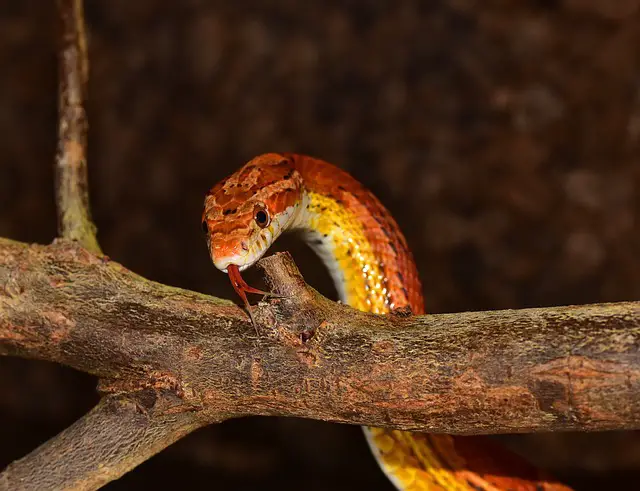Are you a snake lover interested in adding a new pet to your family? If so, you may be debating between a corn snake and a ball python. Both snakes make excellent pets, but one may be better suited for your lifestyle than the other. So let’s take an in-depth look at how they compare.
Would a corn snake make a better pet than a ball python?
When comparing corn snakes to ball pythons, both make excellent pets.
Corn snakes tend to be more docile and may even become tame enough to handle regularly, whereas ball pythons are considered more shy and gentle.
While they might prefer not to be handled regularly, they can still make good pets if given proper attention.
Regarding ease of care and housing, both snakes will do well in a standard 10-20 gallon terrarium, depending on the snake’s size.
Knowing all this, it’s ultimately up to the owner’s preference for which species would make the best pet.
With proper research and understanding of their basic needs, either one can be a great companion for years to come.
Diet and other needs
Corn snakes can live up to fifteen years, and with their bright colors and calm demeanor, they make an excellent choice for amateur snake owners.
They are relatively easy to feed and maintain, as they eat only pre-killed mice or rats once a week, require no specialized lighting or heating, and take up very little space in the home.
Ball pythons may take some more effort to tame and handle, but they can quickly be conducted once they become comfortable with their owner.
They also live up to fifteen years and, like corn snakes, require only pre-killed food and a heating pad or lamp. When it comes down to which to choose, it is entirely up to the individual’s preferences.
Both species can make excellent, long-term companions with the proper care and understanding.
Pros and cons between corn snakes and ball pythons
Corn Snakes:
Pros: Docile and can become tame, bright colors and patterns, low maintenance.
Cons: It can be nippy when not handled regularly and may require more handling than other species.
Ball Pythons:
Pros: Gentle, easy to feed and maintain, long life expectancy.
Cons: Can take more effort to tame and handle, can be shy when not held regularly.
Size Matters
One of the first things to consider when choosing between a corn snake and a ball python is size. Ball pythons generally stay smaller than corn snakes – adults typically reach 3-5 feet in length compared to corn snakes, which can grow up to 5-6 feet.
If space is limited, the ball python may be the better choice. It’s important to note that ball pythons are generally smaller than corn snakes, but they need more space per inch of their body as they grow larger.
Maintenance Needs
In terms of maintenance needs, both species have similar requirements.
They both need warm temperatures (around 80°F during the day and dropping slightly at night) and require a clean environment with regular spot cleaning.
They should also have access to fresh water at all times. Regarding food, both species are primarily carnivores and eat mice or rats, depending on their size.
However, it’s important to note that while ball pythons tend only to eat once every seven days or so, corn snakes usually need to eat two or three times per week due to their higher metabolism rate.
Personality Traits
Regarding personality traits, many people find corn snakes more prone to being active throughout the day than ball pythons, who tend to be crepuscular (functional during dawn and dusk).
Corn snakes can also be somewhat docile when handled if accustomed from an early age, whereas ball pythons can be resistant initially but eventually warm up after regular handling sessions.
Generally speaking, both species will become calmer over time, especially when given plenty of time out of their enclosure for daily handling sessions.
Prices of corn snakes and ball pythons
The prices of corn snakes and ball pythons vary significantly depending on many factors.
Genetically-engineered breeds, such as albino and piebald corn snakes, are often more expensive than the standard variety.
Age is also a significant factor in cost; younger animals often command higher prices due to their vibrant colors and longer lifespans.
The type of breeder you purchase from also has an impact—carefully selected genetics from top-rated breeders tend to come at a higher price tag.
As a responsible pet owner, it is essential to ensure that you are not getting too good to be the real deal, as these might indicate unhealthy animals or false information about the animal’s genetic makeup.
Lastly, location can also factor in whether or not you pay more or less for your snake; prices may vary depending on which area of the country you live in.
Does a corn snake like to be handled more than a ball python?
When it comes to handling, both corn snakes and ball pythons can be enjoyable companions for the experienced reptile owner.
However, there may be a slight difference in preference, as many people have noticed that corn snakes can often become more comfortable with their handlers than ball pythons.
Ball pythons are known to be somewhat shy and reclusive regarding human contact, while corn snakes enjoy exploring their environment, including when humans hold them.
Of course, all reptiles require gentle and regular handling to acclimate to human contact properly, so it’s essential to provide a safe and loving environment when caring for either species.
Conclusion
Choosing between a corn snake and a ball python ultimately comes down to personal preference and individual needs such as size constraints or activity level desired in your pet reptile companion. Do adequate research before deciding which species may be best for you. Regardless of your choice, you’ll likely have a fantastic pet.




